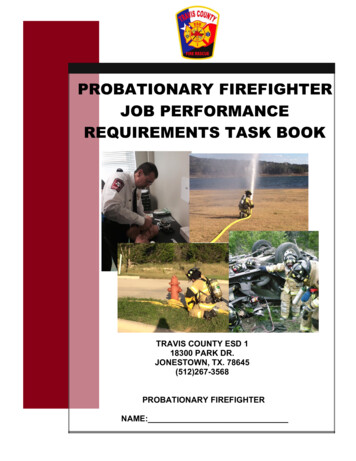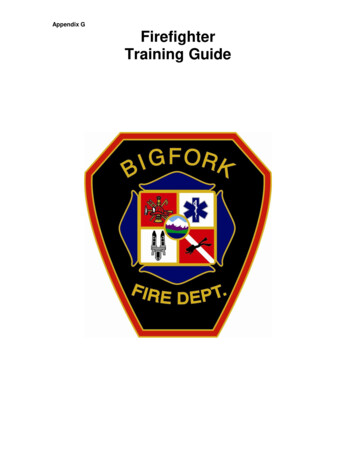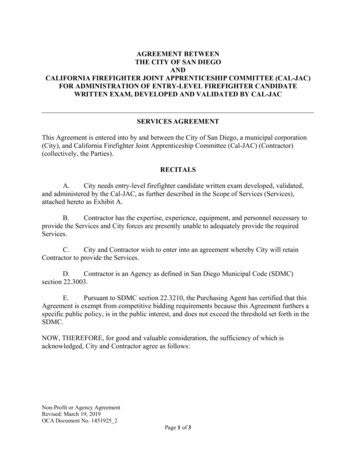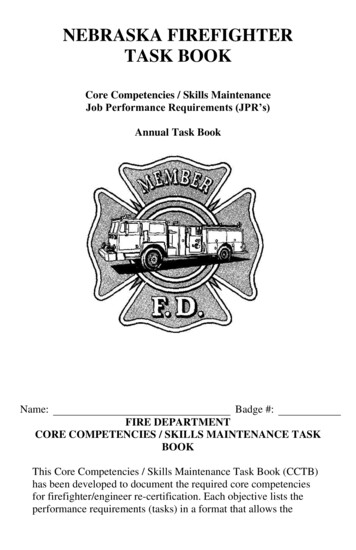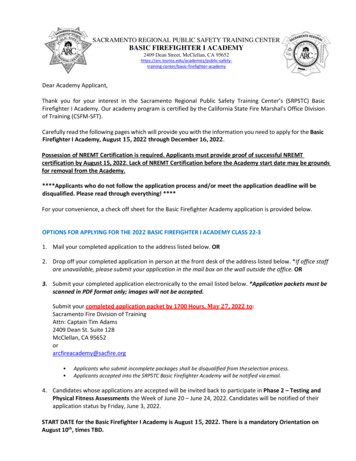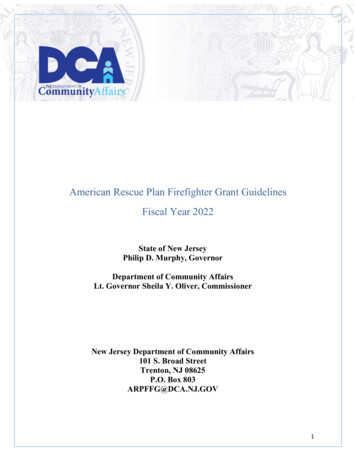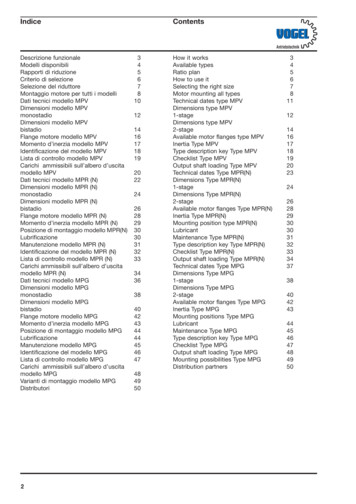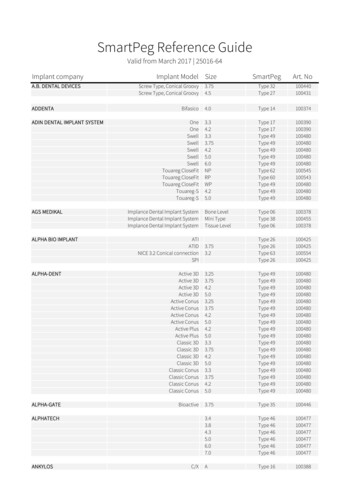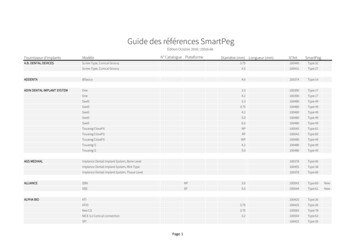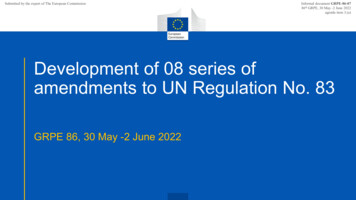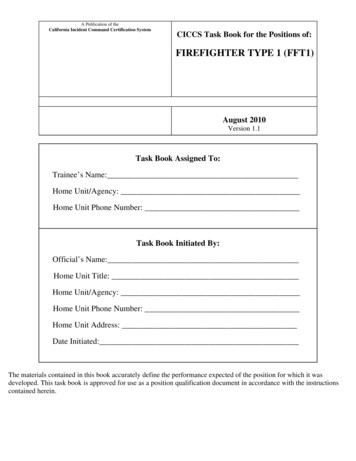
Transcription
A Publication of theCalifornia Incident Command Certification SystemCICCS Task Book for the Positions of:FIREFIGHTER TYPE 1 (FFT1)August 2010Version 1.1Task Book Assigned To:Trainee’s Name:Home Unit/Agency:Home Unit Phone Number:Task Book Initiated By:Official’s Name:Home Unit Title:Home Unit/Agency:Home Unit Phone Number:Home Unit Address:Date Initiated:The materials contained in this book accurately define the performance expected of the position for which it wasdeveloped. This task book is approved for use as a position qualification document in accordance with the instructionscontained herein.
Verification/Certification of Completed Task Book for the Position of:FIREFIGHTER TYPE 1Final Evaluator’s VerificationTo be completed ONLY when you are recommending the trainee for certification.I verify that (trainee name) has successfully performedas a trainee by demonstrating all tasks for the position listed above and should be considered forcertification in this position. All tasks are documented with appropriate initials.Final Evaluator’s Signature:Final Evaluator’s Printed Name:Home Unit Title:Home Unit/Agency:Home Unit Phone Number: Date:Agency CertificationI certify that (trainee name) has met all requirementsfor qualification in the above position and that such qualification has been issued.Certifying Official’s Signature:Certifying Official’s Printed Name:Title:Home Unit/Agency:Home Unit Phone Number: Date:California Incident Command Certification System (CICCS)
POSITION TASK BOOKCICCS Position Task Books (PTB's) have been developed for designated Incident Qualification Systems (IQS) positions.Each PTB lists the competencies, behaviors and tasks required for successful performance in specific positions. Traineesmust be observed completing all tasks and show knowledge and competency in their performance during the completionof this PTB.Trainees are evaluated during this process by qualified evaluators, and the trainee’s performance is documented in thePTB for each task by the evaluator’s initials and date of completion. An Evaluation Record will be completed by allevaluators documenting the trainee’s progress after each evaluation opportunity.Successful performance of all tasks, as observed and recorded by an evaluator, will result in a recommendation to theagency that the trainee be certified in that position. Evaluation and confirmation of the trainee’s performance whilecompleting all tasks may occur on one or more training assignments and may involve more than one evaluator duringany opportunity.ALL HAZARD TRAININGCICCS is committed to transitioning from wildland specific training mandates to all hazard training mandates. Utilizingthe relationship between State Fire Training (SFT) and CICCS will allow for unneeded duplication of trainingrequirements. The CICCS Firefighter Type 1 taskbook is primarily wildland based utilizing the all hazard trainingmandates already being required by the SFT Firefighter 1 program. In training to the all hazard standard for theFirefighter Type 1 position the CICCS committee recommends utilizing the SFT Firefighter 1 training mandates incohesion with the CICCS Firefighter Type 1 taskbook. If it is not an agencies desire to meet all hazard training mandatesfor the Firefighter Type 1 position, it is the recommendation of the CICCS committee to qualify as a Firefighter Type 2NWCG and complete the CICCS Firefighter Type1 taskbook. For a complete breakdown of required experience in theFirefighter Type 1 position refer to the CICCS 2010 positions guide.INCIDENT/EVENT CODINGEach task has a code associated with the type of training assignment where the task may be completed. The codes are:O other, I incident, W wildfire, RX prescribed fire, W/RX wildfire OR prescribed fire and R rare event. Thecodes are defined as:*O Task can be completed in any situation (classroom, simulation, daily job, incident, prescribed fire, etc.).*I Task must be performed on an incident managed under the Incident Command System (ICS). Examples includewildland fire, structural fire, oil spill, search and rescue, hazardous material, and an emergency or non-emergency(planned or unplanned) event.*W Task must be performed on a wildfire incident.*RX Task must be performed on a prescribed fire incident.*W/RX Task must be performed on a wildfire OR prescribed fire incident.*R Rare events such as accidents, injuries, vehicle or aircraft crashes occur infrequently and opportunities to evaluateperformance in a real setting are limited. The evaluator should determine, through interview, if the trainee would be ableto perform the task in a real situation.While tasks can be performed in any situation, they must be evaluated on the specific type of incident/event for whichthey are coded. For example, tasks coded W must be evaluated on a wildfire; tasks coded RX must be evaluated onprescribed fire and so on. Performance of any task on other than the designated assignment is not valid for qualification.
Tasks within the PTB are numbered sequentially; however, the numbering does NOT indicate the order in which thetasks need to be performed or evaluated.The bullets under each numbered task are examples or indicators of items or actions related to the task. The purpose ofthe bullets is to assist the evaluator in evaluating the trainee; the bullets are not all-inclusive. Evaluate and initial ONLYthe numbered tasks. DO NOT evaluate and initial each individual bullet.A more detailed description of this process and definitions of terms are included in theCICCS Administrative Guide. This document can be found at iccs.htmRESPONSIBILITIESThe responsibilities of the Home Unit/Agency, Trainee, Coach, Training Specialist, Evaluator, Final Evaluator andCertifying Official are identified in the CICCS Administrative Guide. It is incumbent upon each of these individuals toensure their responsibilities are met.INSTRUCTIONS FOR THE POSITION TASK BOOK EVALUATION RECORDEvaluation Record #Each evaluator will need to complete an evaluation record. Each evaluation record should be numbered sequentially.Place this number at the top of the evaluation record page and also use it in the column labeled “Evaluation Record #”for each numbered task the trainee has satisfactorily performed.Trainee InformationPrint the trainee’s name, position on the incident/event, home unit/agency, and the home unit/agency address and phonenumber.Evaluator InformationPrint the Evaluator’s name, position on the incident/event, home unit/agency, and the home unit/agency address andphone number.Incident/Event InformationIncident/Event Name: Print the incident/event name.Reference: Enter the incident code and/or fire code.Duration: Enter inclusive dates during which the trainee was evaluated.Incident Kind: Enter the kind of incident (wildfire, prescribed fire, search and rescue, flood, hurricane, etc.).Location: Enter the geographic area, agency, and state.Management Type or Prescribed Fire Complexity Level: Circle the ICS organization level (Type 5, Type 4, Type3, Type 2, Type 1, and Area Command) or the prescribed fire complexity level (Low, Moderate, and High).Fire Behavior Prediction System (FBPS) Fuel Model Group: Circle the Fuel Model Group letter that corresponds tothe predominant fuel type in which the incident/event occurred.G Grass Group (includes FBPS Fuel Models 1 – 3):1 short grass (1 foot); 2 timber with grass understory; 3 tall grass (1½ - 2 feet)B Brush Group (includes FBPS Fuel Models 4 – 6):4 Chaparral (6 feet); 5 Brush (2 feet); 6 dormant brush/hardwood slash;7 Southern roughT Timber Group (includes FBPS Fuel Models 8 – 10)8 closed timber litter; 9 hardwood litter; 10 timber (with litter understory)S Slash Group (includes FBPS Fuel Models 11 – 13)11 light logging slash; 12 medium logging slash; 13 heavy logging slash
Evaluator’s RecommendationFor 1 – 4, initial only one line as appropriate; this will allow for comparison with your initials in the QualificationsRecord.Record additional remarks/recommendations on an Individual Performance Evaluation, or by attaching an additionalsheet to the evaluation record.Evaluator’s SignatureSign here to authenticate your recommendations.DateDocument the date the Evaluation Record is being completed.Evaluator’s Relevant Qualification (or agency certification)List your qualification or certification relevant to the trainee position you supervised.Note: Evaluators must be either qualified in the position being evaluated or supervise the trainee; Final Evaluators mustbe qualified in the trainee position they are evaluating.
TASKCODEBehavior: Ensure readiness for assignment1. Bring adequate personal gear and effects according to agencypolicy. Have available personal protective equipment (PPE). Demonstratethe care and use of PPE utilizing or obtaining items as required byagency policy.Bring other adequate personal gear and effects according to agencypolicy. Report with complete personal gear and effects forextended assignmentMaintain good personal hygiene and fitness2. Follow safety procedures for transporting personnel and equipment. OInspect the condition of hand tools and equipment forserviceability. Check the condition of each tool and identify thosewhich need replacement or repair.Safely sharpen and field maintain commonly used hand tools orreplace as appropriate. Sharpen to standards specified for selectedtool, in field or shop, in a safe manner.4. Inspect hose and accessories for type, size, and condition. OFollow safety procedures for loading, riding, and unloadingpersonnel and equipment in:- Vehicles.- Boats.- Helicopters.- Large transport aircraft.- Small fixed-wing aircraft.Identify agency policy and practice safety procedures appropriateto conditions.Follow safety procedures for foot travel and supervisor’sinstructions.3. Check condition of assigned tools, equipment, and gear; maintain orreplace as appropriate (cutting tools, scraping tools, smothering tools,backpack pump, head lamp). OInspect hose for holes, mildew, rot, damaged threads, andinoperative valves. Correctly recognize and describe each item.Recognize and describe the use of tools: spanner wrench, hoseclamp, hose mender, couplings.OEVALUATIONRECORDNUMBEREVALUATOR:Initial & date uponcompletion of task
TASKCODEEVALUATIONRECORDNUMBERBehavior: Gather, update, and apply situational information relevant to the assignment5. Obtain initial briefing from supervisor. ITask/assignment (instructions may be written and/or oral).Incident situation or conditions.6. Participate in organized and coordinated crew tactical actions.O Identify parts of a fire, including head, perimeter, flank, rear,anchor point, finger, and spot. Identify safety islands and planned escape routes. Describeblackline concept. Demonstrate at least two coordinated crew techniques such as onelick, leapfrog, and bump-up. Describe procedures for direct attack, indirect attack, and parallelattack and when each procedure would be used. Describe seven variations of natural and constructed fire controlline. Demonstrate a thorough familiarity of commonly used terms todescribe what the fire is doing and how it affects fire controltactics in ground fuels, surface fuels, and aerial fuels. Recognize threats to control lines and counter by appropriate linepractices. Describe and/or identify hazards to firefighters. Describe dozer or tractor plow follow-up procedures. Clean up orbreak up machine piles and berms, fireproof needed areas, limbtrees, prepare and burn out control line, mop-up the interior, patrolthe control line.7. List fire weather factors involved in fire suppression. List elements of weather that concerned firefighters use to predictfire behavior.List daily weather processes that can occur in mountainous terrainthat will affect wildland fires.Name sources of unusually strong winds which can occur onwildland fires.Give weather situations which can cause rapid shifts in winddirection.Give visual indicators that suggest the weather is changing.List visible parts of cloud development to indicate it is athunderhead.Describe the safest area around a fire threatened by an approachingthunderhead.OEVALUATOR:Initial & date uponcompletion of task
TASK8. List life threatening situations on wildland fires. ODescribe the fire triangle.Define methods of heat transfer.Identify principle environmental factors affecting fire behavior.Explain how fuel size affects fire behavior.Explain how the arrangement of fuels affects fire behavior.Describe how wind affects fire spread.Give weather factors which affect fuel moisture.Describe how topography affects fire spread.Describe how building construction and arrangement affect firespread.10. Describe how fire suppression may be used to break the firetriangle. ODescribe the dangerous conditions that can develop in a boxcanyon or a steep narrow canyon.Describe fuel situations which could produce explosive firebehavior.List six dangerous situations that call for posting a lookout.Give four alternatives which could be available to escape athreatening fire situation.Given several work situations, identify which of the Standard FireOrders and Watch Out Situations, and/or Urban Interface WatchOut Situations, apply to each situation. Accurately identify eachsituation.List the four major common denominators of fire behavior ontragedy fires.Identify the four components of LCES.Describe potential hazards associated with well involved improvedproperties.9. Identify environmental factors of fire behavior which affect the startand spread of wildland fire. CODEDescribe ways of breaking the fire triangle.Give ways in which constructed fireline can be threatened by fireremaining inside of fireline.Define the blackline concept and how it is used.Describe benefits of defensible space around improved propertiesOEVALUATIONRECORDNUMBEREVALUATOR:Initial & date uponcompletion of task
TASKCODEEVALUATIONRECORDNUMBERBehavior: Establish effective relationships with personnel.11. Conduct self in a professional manner. IRespectful and courteous as an organized crew member.Respectful of public and private property12. Establish and maintain positive interpersonal and interagencyworking relationships.OBehavior: Ensure ability to use tools and knowledge necessary to complete assignment13. Accurately navigate to an assigned destination. Properly use maps and compass (e.g., verify location bycomparing topographic features or street references with map;describe location in terms of coordinates or other acceptabledescription; accurately compute distance and bearing).Properly use Global Positioning System (GPS), if available.14. Participate in reducing the threat of fire exposure to improvedproperties. ODescribe procedures to re-arrange/reduce fuels.Describe or identify procedures to secure hazards.Describe procedures to prepare building/structure.Describe the application of pre-treatment agents (water, foam, gel,and blanket).15. Follow established procedures in securing the fireline. OOContinually inspect condition of tools, equipment, and gear.Maintain or replace as appropriate.Follow established safety procedures when working aroundfireline equipment.Identify hazards and safety procedures when working aroundfireline machinery.Identify hazards to other firefighters and supervisor.16. Extend charged hose lay by properly clamping, disconnecting,inserting, and recoupling hose.OEVALUATOR:Initial & date uponcompletion of task
TASKCODE17. Under supervision select proper nozzle setting and appropriateagent for the job.O Describe fire situation when each of the following will be used:water, foam, gel. Select proper agent and nozzle setting for thejob: fog/spray, straight stream, on/off. Describe each method.18. Adapt to changing work environment. Accept changes in work assignments and conditions due to stagesof the fire. Follow supervisor’s instructions and standards for lineconstruction and mop-up.19. Use safe and effective procedures when utilizing all assigned toolsand equipment (cutting tools, scraping tools, smothering tools,backpack pump, head lamp, firing tools, power tools, weathermonitoring devices). OCarry hand tools properly.Load hand tools safely in vehicles.Use hand tools properly. Correct techniques will be used for eachtool assigned or selected according to fireline condition orrequirement.Assemble, fill, and operate backpack pump. Use safe and efficienttechniques during operation. Store properly.Assemble, fill, and operate power equipment. Use safe andefficient techniques during operation. Store properlyAssemble, fill, and operate firing tools / ignition devices. Use safeand efficient techniques during operation. Store properly.Properly utilize weather monitoring devices20. Properly use fire shelter. IDescribe the correct procedure to select and prepare a site fordeployment, and demonstrate the proper deployment and use ofthe fire shelter.OEVALUATIONRECORDNUMBEREVALUATOR:Initial & date uponcompletion of task
TASK21. Properly use portable or mobile multichannel radio. CODEOUse clear text.Correctly prepare radio for operation.Successfully complete radio check.Select proper channel.Change location to improve reception/transmission (as needed).Protect radio from damage.Use proper radio procedures and techniques.Exercise proper radio discipline.Describe agency procedures for emergency notification(emergency traffic).Describe limitations of radio communications.22. Identify and mark items which are not serviceable.O23. Use the Incident Response Pocket Guide (IRPG) and FirelineHandbook.OBehavior: Understand and comply with ICS concepts and principles24. Apply the ICS. ODiscuss in correct terminology the ICS organization.Follow chain-of-command. Identify two supervisory positionsabove level of FFT1 that would be contacted if the Engine Boss(ENGB) or Crew Boss (CRWB) is not available.Behavior: Model leadership values and principles25. Exhibit principles of duty. Be proficient in your job, both technically and as a leader.Make sound and timely decisions.Ensure tasks are understood, supervised and accomplished.26. Exhibit principles of respect. OKnow your peers and look out for their well-being.Keep your peers informed.Build the team.Employ your peers in accordance with their ial & date uponcompletion of task
TASK27. Exhibit principles of integrity.CODEEVALUATIONRECORDNUMBERO Know yourself and seek improvement. Seek responsibility and accept responsibility for youractions. Set the example.Behavior: Ensure the safety, welfare, and accountability of assigned personnel.28. Provide for the safety and welfare of self and other crew membersand immediately report any threat to their safety. Recognize, mitigate and communicate potentially hazardoussituations during tactical operations.Monitor condition of assigned resources.Provide for care of crew and notify supervisor in event of sickness,injury, or accident.Identify agency policy and practice safety procedures appropriateto conditions.Maintain situational awarenessKnowledge of incident safety message and all communicated riskmanagement priorities29. Serve as lookout. IWEstablish/maintain communications with assigned resources.Choose position with good view of all aspects of hazard, values tobe protected, and personnel.Provide updates on any changes that may compromise the safetyof fireline personnel.Ensures escape routes and safety zones are maintained for lookout.Behavior: Emphasize teamwork30. Assist in crew cohesiveness. OProvide for open communication.Seek commitment.Focus on the team result.Behavior: Ensure relevant information is exchanged during briefings and debriefings31. Obtain tactical assignment from supervisor following the IRPGbriefing checklist. Special considerations and hazards.Values to be protected.IEVALUATOR:Initial & date uponcompletion of task
TASK32. Participate in an After Action Review (AAR)CODEEVALUATIONRECORDNUMBEREVALUATOR:Initial & date uponcompletion of taskIBehavior: Ensure documentation is complete33. Complete required documentation. OEmployee time reportAccidents and injuries reportsICS 214, Unit LogBehavior: Communicate and ensure understanding of work expectations within the chain of commandand across functional areas34. Keep crew members and supervisor informed on a continuing basisabout pertinent information.IBehavior: Gather, analyze, and validate information pertinent to the incident or event and makerecommendations for setting priorities35. Properly size up fire. Hazards and escape routes/safety zones.Point of origin and cause.Size of fire.Location of head.Values to be protected (e.g., improved properties, agricultural,recreational).Weather conditions (current/forecasted).Fuel group (may also include building materials and arrangementof improved properties).TopographyTime of day.Current and expected fire behavior/intensity.36. Monitor, document, and report weather observations.W/RXO
TASKCODEBehavior: Take appropriate action based on assessed risks37. Apply the Risk Management Process found in the IRPG andFireline Handbook. Situation AwarenessHazard AssessmentHazard ControlDecision PointEvaluate38. Develop strategy and apply appropriate tactics for the assignment. OReview priorities, hazards, and fire sensitive areas.Review and refine the ignition/firing plan (verbal or written)utilizing fuel and predicted weather conditions and fire behavior.Explain use of appropriate ignition devices and ensure thosedevices are adequate and operational.Consult with supervisor on “Go/No-Go” decision.Implement a test fire and coordinate with supervisor to ensure thatobjectives can be met.Evaluate ignition/firing activities and modify as needed.40. Patrol Fireline. IEvaluate relevant plans.Use appropriate fire suppression strategy.Develop appropriate tactics based on selected strategy, values tobe protected and expected fire behavior.Maintain status reporting (ICS 201, Incident Briefing).Properly locate fireline.Use appropriate fireline construction methods.Request additional resources as needed.39. Demonstrate proficiency on a low complexity firing operation. ILook for spots across lines.Observe downwind areas utilizing sight and sound.Frequently check dangerous areas on both sides of line.Notify supervisor of spot fires or slopovers.Patrol until the fire is completely safe to leave or you are al & date uponcompletion of task
TASKCODEEVALUATIONRECORDNUMBEREVALUATOR:Initial & date uponcompletion of taskBehavior: Modify approach based on evaluation of incident situation41. Maintain situation awareness and adjust tactics as necessary.IBehavior: Anticipate, recognize, and mitigate unsafe situations42. Identify and correct unsafe actions or conditions.OBehavior: Follow established procedures and/or safety procedures relevant to given assignment43. Identify escape routes and safety zones. Make them known to assigned personnel.Flag route to assure awareness when necessary.W/RXBehavior: Plan for demobilization and ensure demobilization procedures are followed44. Demobilize and check out. Receive demobilization instructions from supervisor.I
Evaluation Record #Trainee Information*Printed Name:*Trainee Position on Incident/Event:*Home Unit/Agency:*Home Unit /Agency Address and Phone Number:Evaluator Information*Printed Name:*Evaluator Position on Incident/Event:*Home Unit/Agency:*Home Unit /Agency Address and Phone Number:Incident/Event Information*Incident/Event Name:*Reference (Incident Number/Fire Code):*Duration:*Incident Kind: Wildfire, Prescribed Fire, All Hazard, Other (specify):*Location (include Geographic Area, Agency, and State):*Management Type (circle one): Type 5, Type 4, Type 3, Type 2, Type 1, Area CommandOR Prescribed Fire Complexity Level (circle one): Low, Moderate, High*FBPS Fuel Model Letter: G Grass, B Brush, T Timber, S SlashEvaluator’s Recommendation(Initial only one line as appropriate)1) The tasks initialed and dated by me on the Qualification Record have been performed under my supervision ina satisfactory manner. The trainee has successfully performed all tasks in the PTB for the position. I havecompleted the Final Evaluator’s Verification section and recommend the trainee be considered for agencycertification.2) The tasks initialed and dated by me on the Qualification Record have been performed under my supervision ina satisfactory manner. However, opportunities were not available for all tasks (or all uncompleted tasks) to beperformed and evaluated on this assignment. An additional assignment is needed to complete the evaluation.3) The trainee did not complete certain tasks in the PTB in a satisfactory manner and additional training,guidance, or experience is recommended.4) The individual is severely deficient in the performance of tasks in the PTB for the position and additionaltraining, guidance, or experience is recommended prior to another training assignment.Record additional remarks/recommendations on an Individual Performance Evaluation, or by attaching an additionalsheet to the evaluation record.Evaluator’s Signature:Date:Evaluator’s Relevant Qualification (or agency certification):
Evaluation Record #Trainee Information*Printed Name:*Trainee Position on Incident/Event:*Home Unit/Agency:*Home Unit /Agency Address and Phone Number:Evaluator Information*Printed Name:*Evaluator Position on Incident/Event:*Home Unit/Agency:*Home Unit /Agency Address and Phone Number:Incident/Event Information*Incident/Event Name:Reference (Incident Number/Fire Code):*Duration:*Incident Kind: Wildfire, Prescribed Fire, All Hazard, Other (specify):*Location (include Geographic Area, Agency, and State):*Management Type (circle one): Type 5, Type 4, Type 3, Type 2, Type 1, Area CommandOR Prescribed Fire Complexity Level (circle one): Low, Moderate, High*FBPS Fuel Model Letter: G Grass, B Brush, T Timber, S SlashEvaluator’s Recommendation(Initial only one line as appropriate)1) The tasks initialed and dated by me on the Qualification Record have been performed under my supervision ina satisfactory manner. The trainee has successfully performed all tasks in the PTB for the position. I havecompleted the Final Evaluator’s Verification section and recommend the trainee be considered for agencycertification.2) The tasks initialed and dated by me on the Qualification Record have been performed under my supervision ina satisfactory manner. However, opportunities were not available for all tasks (or all uncompleted tasks) to beperformed and evaluated on this assignment. An additional assignment is needed to complete the evaluation.3) The trainee did not complete certain tasks in the PTB in a satisfactory manner and additional training,guidance, or experience is recommended.4) The individual is severely deficient in the performance of tasks in the PTB for the position and additionaltraining, guidance, or experience is recommended prior to another training assignment.Record additional remarks/recommendations on an Individual Performance Evaluation, or by attaching an additionalsheet to the evaluation record.Evaluator’s Signature:Date:Evaluator’s Relevant Qualification (or agency certification):
This task book is approved for use as a position qualification document in accordance with the instructions . The CICCS Firefighter Type 1 taskbook is primarily wildland based utilizing the all hazard training mandates already being required by the SFT Firefighter 1 program. In training to the all hazard standard for the
